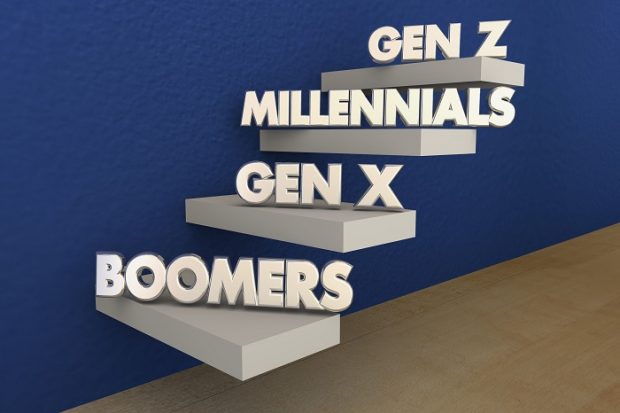 A good financial wellness program should include components that are relevant to each generation's particular points of pain, with solutions delivered in a comfortably accessed format. (Image: Shutterstock)
A good financial wellness program should include components that are relevant to each generation's particular points of pain, with solutions delivered in a comfortably accessed format. (Image: Shutterstock)
Any number of financial pressures are weighing down your employees these days, posing a troublesome burden across age groups, jobs and income categories.
If it's not student loan debt for millennials (and their elders and those behind them, too) that's creating problems. It's the juggling by GenXers to help mom and dad out, save for Junior's college, mortgage, car loan and paying for the emergency dental bill. And many Baby Boomers think they'll never retire, given the shortfall in their retirement savings.
They are paying the price in elevated stress and employers are sharing the pain. Financially stressed employees miss an average of 4.4 more workdays and far more when they were at work but disengaged (12.5) than those without financial stress. And you pay, too, as absenteeism and presenteeism rates climb, and your bottom line is hit with rising healthcare costs since the financially stressed tend to neglect their good eating and health habits.
Related: Financial stress hazardous to emotional, physical health
Some 83 percent of U.S. employers these days have instituted programs to address the problem, an improvement from just a few years ago – as only 20 percent of employers offered them in 2015. More significantly, though, only a third of the workers who could benefit are actually making use of them.
While financial wellness programs that employers typically offer are no doubt well-intended, when they are rated as irrelevant by a big chunk of employees, there's a disconnect that needs to be fixed. Everyone's interests would be better served by framing employee wellness programs more holistically, with financial wellness as important a cornerstone as diet and exercise.
That requires you to think about people's financial education and needs in a way that's more attuned to the individual than the group workshops with one-size-fits-all budgeting calculators that are an easy, common and, let's face it, not-as -effective solution.
A program that is more tailored acknowledges the fact that your workforce is comprised of different generations—perhaps as many as four. Life stages, income levels and family dynamics all play a role in influencing your employees' finances and how they deal with them. And not every group wants to access solutions in the same way.
Your program should include components that are relevant to each group's particular points of pain, with solutions delivered in a comfortably accessed format. It should encompass three broad categories: debt management, asset protection and retirement planning.
There are a number of solutions you can offer to meet their needs, whether you sponsor them or offer them as low-cost voluntary benefits. Here's an overview to think about:
For millennials, help with student loan debt
A hot recruiting target, millennials (1981-1996) are heavily burdened with student loan debt. Any assistance you can provide in managing, consolidating or paying it down (via digital, preferably mobile, channels) will be valued. The need has led to many direct-to-consumer services, but employer-sponsored programs have paid off for everyone as recruitment/retention tools.
It wouldn't hurt to encourage them (along with other groups) to think about retirement planning. One attractive option is to provide plan participants income replacement software tools that indicate how much they should be saving given their account balance and age to build a paycheck for life at retirement age.
Ways GenXers' can manage the 'sandwich'
GenXers (1965-1980) are sometimes called the “sandwich” generation given the financial pressures they juggle around their parents in retirement and their children as they ready for college. They prefer digital resources to help them manage their finances, like access to websites offering basic money courses.
Another issue they may face is coming up with cash for emergencies, making programs like employee purchasing programs attractive. Administered through payroll deductions, these cost employers nothing as they make big ticket purchases affordable, incurring no credit card debt or extra charges.
Baby Boomers want financial options as they look toward retirement
A major issue for Boomers (1946-1964) is retirement readiness, and resources that most appeal will be online or one-on-one coaching. Many are seeing a gap in their retirement savings (the Great Recession took a toll and many are still recouping), and budgeting to reduce debt is one of their challenges. Better managing their investments as retirement nears is another, along with planning for long-term care costs. In addition to money management coaching, it might make particular products attractive, like employer funded long-term care benefits that offer tax advantages for employer and employee.
Structuring an employee wellness program that compliments your overall emphasis on wellness is one thing. Ascertaining that it's working is another—a challenge that 70 percent of employers say they haven't satisfactorily addressed. You might start as you would any time you need insights into targeted audiences, whether customers or employees, with a baseline survey. In this instance, it would shed light on specific financial pressure points and needs of your employee groups and signal the way for programs and services that would help. Future surveys could gauge their progress, aided by tracking of hard data, like absenteeism rates, over time.
The financial wellness of today's workforce is a burden that everyone shares. Employers who take it upon themselves to address the issue with solutions that are useful and relevant will go a long way toward improving everyone's fortunes over the long term.
Read more:
- Financial wellness programs need nurturing to succeed
- 5 financial wellness predictions in 2019
- Holistic wellness: Why it matters now
 Michelle Clark is senior vice president, health & performance for HUB International. She leads a team of consultants focused on helping companies help their employees be their healthiest selves, so they can be happy, healthy and productive individuals.
Michelle Clark is senior vice president, health & performance for HUB International. She leads a team of consultants focused on helping companies help their employees be their healthiest selves, so they can be happy, healthy and productive individuals.
© 2025 ALM Global, LLC, All Rights Reserved. Request academic re-use from www.copyright.com. All other uses, submit a request to [email protected]. For more information visit Asset & Logo Licensing.







